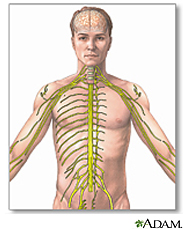 |
 |
 |
||
    |
||||
|
||||
|
Other Health Topics:
Polio and Post-Polio Syndrome
Also called: Infantile paralysis, Poliomyelitis, PPS
Polio is an infectious disease caused by a virus. It attacks your nervous system. In rare cases, polio infection can cause paralysis. Polio vaccination will protect most people for life. The United States and most other countries eradicated polio decades ago, except for rare cases. The disease most commonly affects young children. Poliovirus spreads in human waste. People usually get it from contaminated food or water. Symptoms include fever, tiredness, vomiting, neck stiffness, and leg and arm pain. Most infected people never have symptoms. No treatment will reverse polio paralysis. Moist heat, physical therapy and medicines might ease symptoms. Some people who've had polio develop post-polio syndrome (PPS) years later. Symptoms include tiredness, new muscle weakness and muscle and joint pain. There is no way to prevent or cure PPS. World Health Organization
Start Here
|
| Home | Health Topics | Drugs & Supplements | Encyclopedia | Dictionary | News | Directories | Other Resources | |
| Disclaimers | Copyright | Privacy | Accessibility | Quality Guidelines U.S. National Library of Medicine, 8600 Rockville Pike, Bethesda, MD 20894 National Institutes of Health | Department of Health & Human Services |
Date last updated: 04 May 2009 Topic last reviewed: 18 November 2008 |


